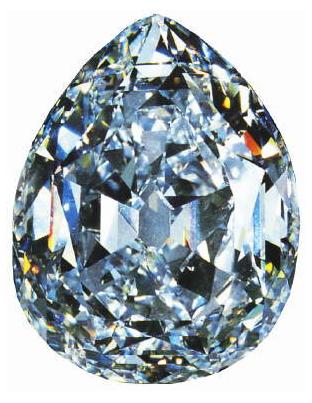
AND NOW...
A compilation of utterly useless information brought to you by www.diamonds-are-forever.org.uk and THE NATIONAL NEWSPICKER™...
Honoring the discovery of the world's largest diamond in South Africa on January 25th, 1905 we proudly present:
Amazing Facts About the Cullinan Diamond
 |
| The Cullinan I, a.k.a. the "Star of Africa" |
- The giant Cullinan is one of the most famous and the largest diamond in the world. The Cullinan weighed a massive 3,106 carats as a rough diamond crystal. The rough diamond was 10 cm long, 6 cm high and 5 cm thick.
- The Cullinan Diamond was named after Thomas Cullinan (later Sir Thomas) who was a South African businessman. Thomas Cullinan was a successful Johannesburg building contractor and amateur geologist. Thomas became interested in the area because of the alluvial diamonds that were being found in nearby stream.
- The Cullinan diamond was discovered at the Premier Diamond Mine in 1905. Mr. Frederick Wells, the superintendent of the Premier Mine found the crystal when he was making a routine inspection of the mine, eighteen feet below the ground. Frederick Wells received 3,500 pounds as a reward.
- The Cullinan was sold to the Transvaal government for £150,000 who presented it to King Edward VII on his 66th birthday on November 9th, 1907.
- King Edward VII entrusted Abraham and Joseph Asscher, of the famous Royal Asscher Diamond Company in Amsterdam, with cutting the giant stone which was finally finished in 1908.
- The Asscher brothers studied the giant sized rough diamond for three months before making the final decision of where the diamond should be cut.
- On February 10, 1908 Joseph Asscher prepared himself for the greatest responsibility of his life - the cleaving of the giant Cullinan rough diamond. The tension, pressure and stress on Joseph Asscher can hardly be imagined. He was responsible for cutting the biggest and most expensive diamond in the world and a mistake in this task would, literally, cost a fortune.
- Joseph Asscher placed the cleaving blade at the prearranged point of the diamond and struck the blade with his hammer. To his horror the cleaving blade broke. Thankfully, the diamond was unharmed. A special, extra large, cleaving blade was obtained. The second attempt was understandably even more tense than the first. Failure was unthinkable. Joseph Asscher struck the rough diamond again but this time it split perfectly into three large sections. These sections were closely studied and then divided into nine principal diamonds.
- The nine diamonds today are found in either in the British Regalia, the English Crown Jewels, or in the personal possession of the British Royal Family.
- After cutting the giant rough Cullinan diamond the following stones were created each being given different numbers according to their diminishing weights. Facts and information about each of the diamonds are listed below together with details of their current mountings:
- The Cullinan I aka the Star of Africa cut into a pear shape and weighing 530.20 carats is set in the Royal Sceptre
- The Cullinan II in the center-front of the Imperial State Crown of Great Britain was cut into a cushion shape and weighing 317.40 carats is mounted in the band of the Imperial State Crown
- The Cullinan III is cut into a pear shape and weighing 94.40 carats is mounted in the finial (an ornament projecting as a round or oval shape ) of Queen Mary's Crown. It can also be worn as a pendant-brooch
- The Cullinan IV is set in the band of Queen Mary's crown after being cut into a square cushion shape and weighing 63.60 carats. It can also be worn as a pendant-brooch
- The Cullinan V was originally mounted in a brooch for Queen Mary but now used as a replacement for the Koh-i-Noor diamond which was used in a new crown made for Queen Elizabeth (Queen Mother) in 1937. It was cut into a heart shape and weighs 18.50 carats
- The Cullinan VI is set in a diamond and emerald necklace was cut into a marquise shape and weighing 11.50 carats
- The Cullinan VII is mounted as a pendant drop on a diamond brooch, cut into a marquise shape and weighing 8.80 carats
- The Cullinan VIII was cut into a rectangular cushion and weighing 6.80 carats. It is mounted as the centre diamond on the same brooch as the Cullinan VII
- The Cullinan IX was cut into a pear shape, weighing 4.39 carats and set in a ring.
- The Premier Diamond mine in South Africa, where the Cullinan diamond was found, is situated on an ancient diamond-bearing kimberlite pipe. The pipe is a carrot-shaped volcanic neck originating from great depths within the Earth and is the largest in South Africa.
- Diamonds are formed when extreme heat and extreme pressure cause carbon atoms to crystallize forming diamonds approximately ninety miles under the earth's surface. Diamonds reach the surface of the earth via volcanic pipes, or channels.
-----------------------------------------------------------------------------
HEY YOU! Yes you. You are invited to submit your own favorite amazing fact or statistic. If you’d like, we’ll even publish your name (or your organization’s name) and give you credit for your contribution. Note: Unless you are particularly dense, you will recognize that we are actually offering you FREE PUBLICITY in exchange for a mere tidbit of information.
Simply click on the hyperlink below to submit your gem:

Capital, Traffic Building, International Customers and unique SERVICES.
The National Networker Publications™ produced by TNNWC Group, LLC
Resources for Business Planning, Development, Capital and Growth
Forward/Share This Article With Colleagues And Social Media:










No comments:
Post a Comment